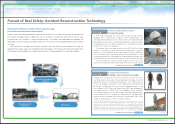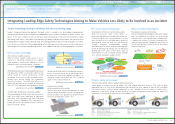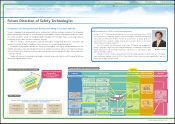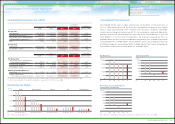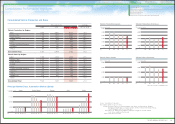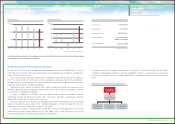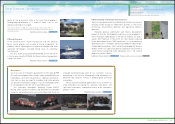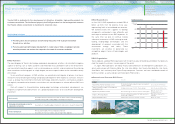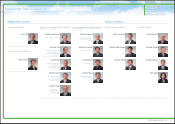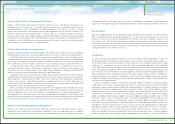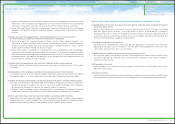Toyota 2011 Annual Report Download - page 25
Download and view the complete annual report
Please find page 25 of the 2011 Toyota annual report below. You can navigate through the pages in the report by either clicking on the pages listed below, or by using the keyword search tool below to find specific information within the annual report.
Business and
Performance Review
Special Feature
Management and
Corporate Information
Financial Section and
Investor InformationMessage/Vision
New Business Activities
Realization of a our new vision of the “future mobility society” requires the widespread use of next-
generation environment-friendly cars as well as an infrastructure that can properly manage electricity
demand. Toyota is strengthening our smart grid effort, and that effort includes moving forward with
trials and testing in various regions and our active cooperation with other industries.
The Toyota smart grid concept
Efforts to make smart grids a reality
Cooperation with other industries to speed up smart grid development
The Toyota Smart Center optimizes environment-friendly car battery charging
and home energy management
Participation in trials worldwide
Use of the latest IT technology and the expanding data infrastructure
The daily power use of environment-friendly cars such as plug-in hybrid vehicles (PHVs) and electric
vehicles (EVs) is thought to be equal to 30% of the power consumption of the average home. Achievement
of a low-carbon society will require the widespread use of environment-friendly cars, so optimal
management of battery charging and home energy is essential. To meet this aim we have developed our
Toyota Smart Center, a system that uses smart-grid technology to link homes, vehicles, and users.
The smart grid envisioned by Toyota is centered on the Smart Center, and manages the power supply
to “smart houses” developed by Toyota Housing while monitoring the power use status of each home
through a data center. This enables it to reduce the CO
2
emissions of the entire region while minimizing
costs. It does so by monitoring both the remaining battery power data transmitted by the car and the power
consumption data from the home, and then proceeds to make a comprehensive determination about how
to optimize power use by also taking into account factors such as weather conditions and power company
fee schedules. Car batteries can then be charged during times of day when the grid power load is low, and
the home’s own power supply from solar panels and storage batteries can be used efficiently. The goal is
to create “smart communities” that optimize the power usage of the entire residential area.
Toyota is conducting trials in Japan and a number of countries, such as the United States, China, and France,
in cooperation with national and local governments, so as popularize smart grids and environment-friendly cars.
Toyota actively seeks cooperation with other industries.
In April of this year, Toyota teamed up with Microsoft to establish
Windows Azure cloud service as the IT platform for operating Toyota’s own
data center, with the goal of reducing costs and achieving systems
expandability. The two companies will work together to build a global cloud
platform by 2015 to develop the Toyota Smart Center worldwide, with the
goal of early achievement of a low-carbon, energy efficient society.
Also in April, Toyota teamed up with WiTricity to develop wireless, “non-
contact charging” that charges up batteries simply by bringing them into
proximity with chargers embedded in homes or parking spaces. In May, Toyota
and Salesforce.com formed a strategic alliance to build “Toyota Friend,” a
private social network for connecting people, cars, dealers and manufacturers.
France
Project in cooperation with the French government to build
a power management system utilizing solar power.
* Institut National de l’Energie Solaire
INES* project
Project conducted in cooperation
with EDF (French power company),
consisting of introducing 70 PHVs,
confirming vehicle/infrastructure
performance and assessing battery
charging.
Strasbourg
First city-level project to evaluate PHV usability and charging
performance and conduct trials of home/PHV links.
Boulder, Colorado
America
Joint project with CATARC (China Automotive Technology and
Research Center) to evaluate PHV usability and charging performance.
Tianjin
China
Trials involving powering homes and PHVs using only
natural (wind + solar) energy
Rokkasho Village, Aomori Prefecture
Project with the Ministry of Economy, Trade, and Industry (METI) conducting regional
public relations with local governments in 18 designated model prefectures nationwide
including, encouraging the use of environment-friendly cars as public service vehicles.
EV/PHV Towns
Project with METI that conducts trials in plant energy management, which is of
particular interest because of Kitakyushu’s status as an industrial city.
Kitakyushu City, Fukuoka Prefecture
Project conducted in cooperation with METI that involves the sale of 67 Toyota
Housing demonstration houses and is aimed at optimizing energy use from a consumer
perspective. Four thousand production-model PHVs and EVs were introduced as part
of the effort to construct a low-carbon transportation system.
Toyota City, Aichi Prefecture
Japan
Alliances with Microsoft (top photo)
and Salesforce.com (bottom photo)
Smart grid Toyota envisions
Toyota Smart Center
Total support for low-carbon,
energy-saving life
Power company
Electricity rates by periods
Sunlight / Temperature / Wind
Gathering
data
Optimum
calculation
for
energy use
Power
consumption/
storage
planning
Leveling of power demand
Self-supplying
power
06 12 18 23
Home
power consumption
Car
charging
Shifting car-charging
to periods with low
power demand
Demand power
(hour)
Town (smart shop) People
(smart phone)
WiFi network Solar panels
Charging outlet
G-Station
Notifies smart phones
when charging ends
HEMS*
Controls home electricity supply/demand
(generation, storage, consumption)
G-BOOK
Network connecting cars,
homes and people
Supporting eco-driving
Checking battery level
Setting charging time
Remote air-conditioning
Supporting ECO life
Home power consumption monitor
Appliances remote control
Car batteries
Used as a household power source
in emergencies
Storage battery
Stores electricity generated
by solar panels
Home
(smar t house)
Car (PHV, EV)
Consolidated Performance Highlights
Automotive Operations
Restore and Renew Our Production Structure for Further Growth
Financial Services Operations
Other Business Operations
New Business Activities
Support for Recovery from the Great East Japan Earthquake
0819
25
TOYOTA ANNUAL REPORT 2011
*HEMS: Home Energy Management System


